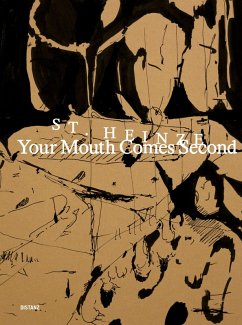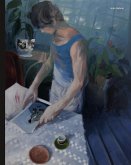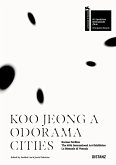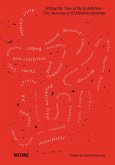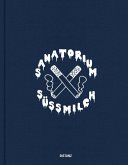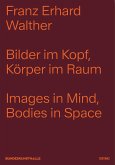Der heimliche Weg hinein
Der künstlerische Arbeitsprozess von Stefanie Heinze (geb. 1987 in Berlin; lebt und arbeitet in New York, USA) widersetzt sich der einfachen Einordnung in Abstraktion oder Figuration. Die Künstlerin beginnt mit kleinformatigen Zeichnungen und Collagen, die dann in großflächige Tableaus übersetzt werden. Das Zeichnen ist für sie ein innerer Akt, ein Prozess der Reduktion, während das Malen einen äußeren Akt darstellt, einen Akt der Produktion. Bildmotive werden ständig abgetragen und wieder hinzugefügt, sie bewegen sich zwischen Negation und Addition. In ihrer ständigen Metamorphose und Veränderung unterbricht Heinze die Unterscheidung zwischen sogenannter Hoch- und Popkultur, von der Bildwelt, die sie zitiert, bis hin zur Behandlung der Farbe selbst.
Your Mouth Comes Second ist die erste institutionelle Einzelausstellung, die eine Auswahl aktueller Werke zeigt, die zentrale Anliegen von Stefanie Heinze widerspiegeln: die Darstellung und Verarbeitung von rohen Materialien, die Erkundung von Zärtlichkeit und Verletzlichkeit, Gemeinschaft und die Verflechtung von antiker und urbaner Spiritualität. Inspiriert von diesen gegensätzlichen Wissensquellen erforscht die Ausstellung, was vor, mit und nach der Sprache kommt, wobei ein empirisches Vokabular und die sinnliche Erfahrung der Malerei im Vordergrund stehen.
Die erste Monografie über das Werk von Stefanie Heinze bringt ihre Gemälde, Zeichnungen und Collagen in einen Dialog mit einer Vielzahl von Texten: Gedichte von Fid. Fischer und Sophie Robinson, Essays von Mason Leaver-Yap und Miciah Hussey und ein Gespräch zwischen Mason Leaver-Yap und der Künstlerin.
The Clandestine Way In
Stefanie Heinze's (b. Berlin, 1987; lives and works in New York, US) artistic process refutes the easy classification of abstraction or figuration. The artist starts with small-scale drawings and collages, which are then translated to sweeping tableaus. For her, drawing is an internal act, a process of reduction, while painting is an external act, one of production. Imagery is constantly cut away and built back up, existing somewhere between negation and addition. In its constant metamorphosis and change, Heinze's work disrupts distinctions between so-called high and low culture, from the imagery she cites to the treatment of the paint itself.
Your Mouth Comes Second is the first solo institutional exhibition which brings together a selection of recent works reflecting the artist's central concerns: the depiction and processing of raw materials, the exploration of tenderness and vulnerability, companionship, and the integration of ancient and urban spiritualism. Inspired by these counterhegemonic sources of knowledge, the exhibition explores what comes before, with, and after language, emphasizing an empirical vocabulary and the sensory experience of painting.
Stefanie Heinze's first monograph with the same title presents her paintings, drawings, and collages in dialogue with a rich selection of writings: poems by Fid. Fischer and Sophie Robinson, essays by Mason Leaver-Yap and Miciah Hussey, and a conversation between Mason Leaver-Yap and the artis
Hinweis: Dieser Artikel kann nur an eine deutsche Lieferadresse ausgeliefert werden.
Der künstlerische Arbeitsprozess von Stefanie Heinze (geb. 1987 in Berlin; lebt und arbeitet in New York, USA) widersetzt sich der einfachen Einordnung in Abstraktion oder Figuration. Die Künstlerin beginnt mit kleinformatigen Zeichnungen und Collagen, die dann in großflächige Tableaus übersetzt werden. Das Zeichnen ist für sie ein innerer Akt, ein Prozess der Reduktion, während das Malen einen äußeren Akt darstellt, einen Akt der Produktion. Bildmotive werden ständig abgetragen und wieder hinzugefügt, sie bewegen sich zwischen Negation und Addition. In ihrer ständigen Metamorphose und Veränderung unterbricht Heinze die Unterscheidung zwischen sogenannter Hoch- und Popkultur, von der Bildwelt, die sie zitiert, bis hin zur Behandlung der Farbe selbst.
Your Mouth Comes Second ist die erste institutionelle Einzelausstellung, die eine Auswahl aktueller Werke zeigt, die zentrale Anliegen von Stefanie Heinze widerspiegeln: die Darstellung und Verarbeitung von rohen Materialien, die Erkundung von Zärtlichkeit und Verletzlichkeit, Gemeinschaft und die Verflechtung von antiker und urbaner Spiritualität. Inspiriert von diesen gegensätzlichen Wissensquellen erforscht die Ausstellung, was vor, mit und nach der Sprache kommt, wobei ein empirisches Vokabular und die sinnliche Erfahrung der Malerei im Vordergrund stehen.
Die erste Monografie über das Werk von Stefanie Heinze bringt ihre Gemälde, Zeichnungen und Collagen in einen Dialog mit einer Vielzahl von Texten: Gedichte von Fid. Fischer und Sophie Robinson, Essays von Mason Leaver-Yap und Miciah Hussey und ein Gespräch zwischen Mason Leaver-Yap und der Künstlerin.
The Clandestine Way In
Stefanie Heinze's (b. Berlin, 1987; lives and works in New York, US) artistic process refutes the easy classification of abstraction or figuration. The artist starts with small-scale drawings and collages, which are then translated to sweeping tableaus. For her, drawing is an internal act, a process of reduction, while painting is an external act, one of production. Imagery is constantly cut away and built back up, existing somewhere between negation and addition. In its constant metamorphosis and change, Heinze's work disrupts distinctions between so-called high and low culture, from the imagery she cites to the treatment of the paint itself.
Your Mouth Comes Second is the first solo institutional exhibition which brings together a selection of recent works reflecting the artist's central concerns: the depiction and processing of raw materials, the exploration of tenderness and vulnerability, companionship, and the integration of ancient and urban spiritualism. Inspired by these counterhegemonic sources of knowledge, the exhibition explores what comes before, with, and after language, emphasizing an empirical vocabulary and the sensory experience of painting.
Stefanie Heinze's first monograph with the same title presents her paintings, drawings, and collages in dialogue with a rich selection of writings: poems by Fid. Fischer and Sophie Robinson, essays by Mason Leaver-Yap and Miciah Hussey, and a conversation between Mason Leaver-Yap and the artis
Hinweis: Dieser Artikel kann nur an eine deutsche Lieferadresse ausgeliefert werden.

